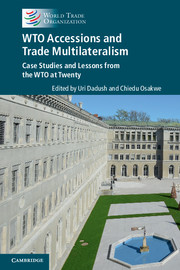Book contents
- Frontmatter
- Dedication
- Contents
- List of contributors
- Foreword
- Acknowledgements
- List of abbreviations
- Editors' note
- PART I WTO accessions, the trading system and the global economy
- PART II Overview: systemic outcomes from accessions
- 9 Contributions and lessons from WTO accessions: the present and future of the rules-based multilateral trading system
- 10 WTO rule-making: WTO Accession Protocols and jurisprudence
- 11 The evolution of the GATT/WTO Accession Protocol: legal tightening and domestic ratification
- PART III Members’ perspectives on accession negotiations
- PART IV Working party chairpersons’ perspectives on accession negotiations
- PART V Salient features inWTOAccession Protocols
- PART VI Conclusion
- Annex: Contributor biographies
- Index
- Plate section
11 - The evolution of the GATT/WTO Accession Protocol: legal tightening and domestic ratification
from PART II - Overview: systemic outcomes from accessions
Published online by Cambridge University Press: 05 November 2015
- Frontmatter
- Dedication
- Contents
- List of contributors
- Foreword
- Acknowledgements
- List of abbreviations
- Editors' note
- PART I WTO accessions, the trading system and the global economy
- PART II Overview: systemic outcomes from accessions
- 9 Contributions and lessons from WTO accessions: the present and future of the rules-based multilateral trading system
- 10 WTO rule-making: WTO Accession Protocols and jurisprudence
- 11 The evolution of the GATT/WTO Accession Protocol: legal tightening and domestic ratification
- PART III Members’ perspectives on accession negotiations
- PART IV Working party chairpersons’ perspectives on accession negotiations
- PART V Salient features inWTOAccession Protocols
- PART VI Conclusion
- Annex: Contributor biographies
- Index
- Plate section
Summary
ABSTRACT
Where are the legal roots of WTO Accession Protocols? How much was carried over from the General Agreement on Tariffs and Trade standard and practice? What customary practice governs the preparation and approval of accession decisions and protocols? What is the current substantive standard and basic architecture of Accession Protocols? Are there unique provisions in Accession Protocols that have emerged in twenty years of WTO accession history? To what extent do Accession Protocols come into play in the context of WTO dispute settlement? By comparing the empirical data contained in the WTO Accession Protocols with preceding GATT Accession Protocols, this chapter offers waterfront coverage of WTO Accession Protocols from the GATT baseline. The chapter shows that, although rooted in its GATT predecessor base, and remarkably consistent over time, some unique provisions have been incorporated into the architecture of the WTO Accession Protocols since 1995. Because Accession Protocols become integral parts of WTO Agreement after they come into force, the chapter argues that the specific ‘terms and conditions of accession’ in WTO Accession Protocols have had a direct and salutary impact on the entirety of the WTO Agreement through its tightened safeguard and upgrade. The chapter concludes by arguing that the evidence suggests that the WTO Agreement has been expanded by the absorption of the Accession Protocols over the course of the last twenty years, and that the effect on the WTO Agreement has been significant, rather than marginal.
Accession to the [World Trade Organization] is achieved through negotiation with other WTO Members. Pursuant to Article XII of the Marrakesh Agreement [Establishing the World Trade Organization], accessions take place ‘on terms to be agreed’ between the acceding Member and the WTO membership. Most accession processes take several years to complete and lead to detailed negotiated provisions. The terms of each WTO Member's accession are set out in its Accession Protocol and accompanying Working Party Report. The negotiated agreement between the WTO membership and the acceding Member results in a delicate balance of rights and obligations, which are reflected in the specific wording of each commitment set out in these documents. Ultimately, the acceding Member and the WTO membership recognize that the intensively negotiated content of an Accession Package is the ‘entry fee’ to the WTO system.
- Type
- Chapter
- Information
- WTO Accessions and Trade MultilateralismCase Studies and Lessons from the WTO at Twenty, pp. 348 - 394Publisher: Cambridge University PressPrint publication year: 2015

